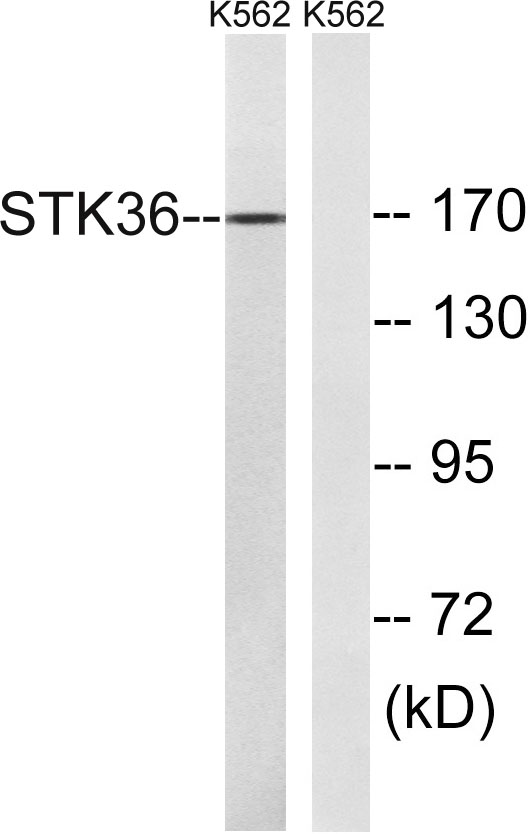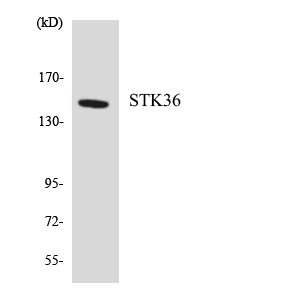STK36 Polyclonal Antibody
- 货号:YT4462
- 应用:WB;IHC;IF;ELISA
- 种属:Human;Mouse
- 蛋白名称:
- Serine/threonine-protein kinase 36
- 免疫原:
- The antiserum was produced against synthesized peptide derived from human STK36. AA range:387-436
- 特异性:
- STK36 Polyclonal Antibody detects endogenous levels of STK36 protein.
- 组成:
- Liquid in PBS containing 50% glycerol, 0.5% BSA and 0.02% sodium azide.
- 来源:
- Polyclonal, Rabbit,IgG
- 稀释:
- WB 1:500 - 1:2000. IHC 1:100 - 1:300. ELISA: 1:5000.. IF 1:50-200
- 纯化工艺:
- The antibody was affinity-purified from rabbit antiserum by affinity-chromatography using epitope-specific immunogen.
- 储存:
- -15°C to -25°C/1 year(Do not lower than -25°C)
- 其他名称:
- STK36;KIAA1278;Serine/threonine-protein kinase 36;Fused homolog
- 背景:
- This gene encodes a member of the serine/threonine kinase family of enzymes. This family member is similar to a Drosophila protein that plays a key role in the Hedgehog signaling pathway. This human protein is a positive regulator of the GLI zinc-finger transcription factors. Knockout studies of the homologous mouse gene suggest that defects in this human gene may lead to congenital hydrocephalus, possibly due to a functional defect in motile cilia. Because Hedgehog signaling is frequently activated in certain kinds of gastrointestinal cancers, it has been suggested that this gene is a target for the treatment of these cancers. Alternative splicing of this gene results in multiple transcript variants. [provided by RefSeq, Aug 2011],
- 功能:
- catalytic activity:ATP + a protein = ADP + a phosphoprotein.,cofactor:Magnesium.,function:Serine/threonine protein kinase required for postnatal development, possibly by regulating the homeostasis of cerebral spinal fluid or ciliary function. Controls the activity of the transcriptional regulators GLI1, GLI2 and GLI3 by opposing the effect of SUFU and promoting their nuclear localization. GLI2 requires an additional function of STK36 to become transcriptionally active, but the enzyme does not need to possess an active kinase catalytic site for this to occur.,similarity:Belongs to the protein kinase superfamily. Ser/Thr protein kinase family.,similarity:Contains 1 protein kinase domain.,subcellular location:Low levels also present in the nucleus.,tissue specificity:Expressed at low levels in most fetal tissues, adult ovaries and at high levels in adult testis, where it is localized in ger
- 细胞定位:
- Cytoplasm . Nucleus . Cytoplasm, cytoskeleton, cilium axoneme . Low levels also present in the nucleus. .
- 组织表达:
- Expressed at low levels in most fetal tissues, adult ovaries and at high levels in adult testis, where it is localized in germ cells (PubMed:10806483). Expressed in respiratory epithelial cells of the lung (PubMed:28543983).

- Immunohistochemistry analysis of paraffin-embedded human lung carcinoma tissue, using STK36 Antibody. The picture on the right is blocked with the synthesized peptide.

- Western blot analysis of lysates from K562 cells, using STK36 Antibody. The lane on the right is blocked with the synthesized peptide.

- Western blot analysis of the lysates from HepG2 cells using STK36 antibody.






